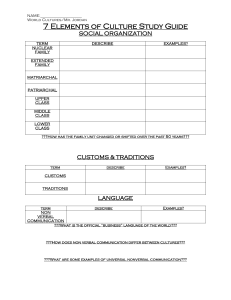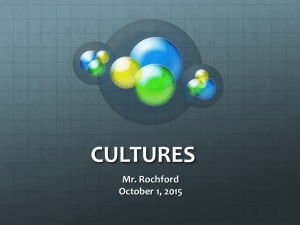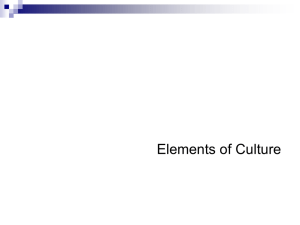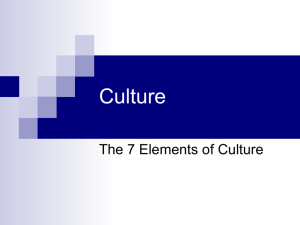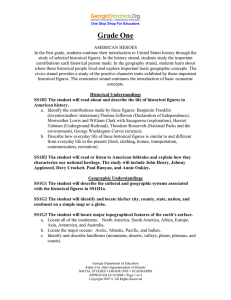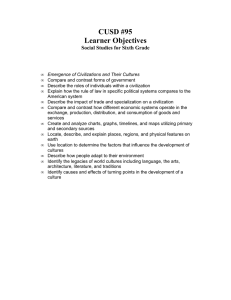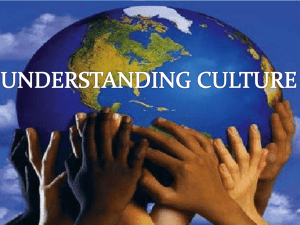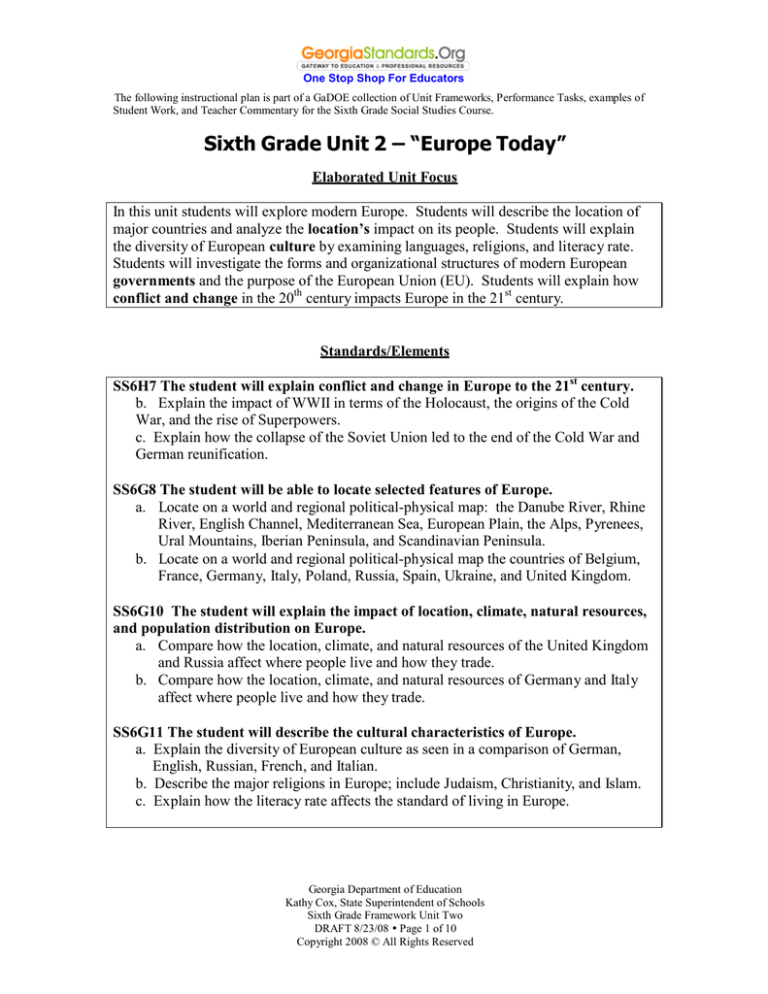
One Stop Shop For Educators
The following instructional plan is part of a GaDOE collection of Unit Frameworks, Performance Tasks, examples of
Student Work, and Teacher Commentary for the Sixth Grade Social Studies Course.
Sixth Grade Unit 2 – “Europe Today”
Elaborated Unit Focus
In this unit students will explore modern Europe. Students will describe the location of
major countries and analyze the location’s impact on its people. Students will explain
the diversity of European culture by examining languages, religions, and literacy rate.
Students will investigate the forms and organizational structures of modern European
governments and the purpose of the European Union (EU). Students will explain how
conflict and change in the 20th century impacts Europe in the 21st century.
Standards/Elements
SS6H7 The student will explain conflict and change in Europe to the 21st century.
b. Explain the impact of WWII in terms of the Holocaust, the origins of the Cold
War, and the rise of Superpowers.
c. Explain how the collapse of the Soviet Union led to the end of the Cold War and
German reunification.
SS6G8 The student will be able to locate selected features of Europe.
a. Locate on a world and regional political-physical map: the Danube River, Rhine
River, English Channel, Mediterranean Sea, European Plain, the Alps, Pyrenees,
Ural Mountains, Iberian Peninsula, and Scandinavian Peninsula.
b. Locate on a world and regional political-physical map the countries of Belgium,
France, Germany, Italy, Poland, Russia, Spain, Ukraine, and United Kingdom.
SS6G10 The student will explain the impact of location, climate, natural resources,
and population distribution on Europe.
a. Compare how the location, climate, and natural resources of the United Kingdom
and Russia affect where people live and how they trade.
b. Compare how the location, climate, and natural resources of Germany and Italy
affect where people live and how they trade.
SS6G11 The student will describe the cultural characteristics of Europe.
a. Explain the diversity of European culture as seen in a comparison of German,
English, Russian, French, and Italian.
b. Describe the major religions in Europe; include Judaism, Christianity, and Islam.
c. Explain how the literacy rate affects the standard of living in Europe.
Georgia Department of Education
Kathy Cox, State Superintendent of Schools
Sixth Grade Framework Unit Two
DRAFT 8/23/08 Page 1 of 10
Copyright 2008 © All Rights Reserved
One Stop Shop For Educators
SS6CG4 The student will compare and contrast various forms of government.
a. Describe the ways government systems distribute power: unitary, confederation,
and federal.
b. Explain how governments determine citizen participation: autocratic, oligarchic,
and democratic.
c. Describe the two predominant forms of democratic governments: parliamentary
and presidential.
SS6CG5 The student will explain the structure of modern European governments.
a. Compare the parliamentary system of the United Kingdom of Great Britain and
Northern Ireland (United Kingdom), the federal system of the Federal Republic of
Germany (Germany), and the federation of the Russian Federation (Russia),
distinguishing the form of leadership and the role of the citizen in terms of voting
and personal freedoms.
b. Describe the purpose of the European Union and the relationship between
member nations.
Enduring Understandings/Essential Questions
CONFLICT & CHANGE: The student will understand that when there is conflict
between or within societies, change is the result.
How did the differing philosophies of the United States and the Soviet Union after
WWII lead to the Cold War?
Why is the Holocaust a significant event of WWII?
What events led to the collapse of the Soviet Union?
What events led to the reunification of Germany?
What is the relationship between the collapse of the Soviet Union, the reunification
of Germany, and the end of the Cold War?
CULTURE: The student will understand that the culture of a society is the product
of the religion, beliefs, customs, traditions, and government of that society.
How does the diversity of languages in Europe (German, English, Russian, French,
Italian) reflect its unique cultural characteristics?
How do the people of Europe overcome the barriers created by the diversity of
cultures?
What are the characteristics of the three major religions in Europe (Judaism,
Christianity, Islam)?
What is the relationship between literacy rate and standard of living?
Georgia Department of Education
Kathy Cox, State Superintendent of Schools
Sixth Grade Framework Unit Two
DRAFT 8/23/08 Page 2 of 10
Copyright 2008 © All Rights Reserved
One Stop Shop For Educators
GOVERNANCE: The student will understand that as a society increases in
complexity and interacts with other societies, the complexity of the government also
increases.
How is power distributed in different forms of government (unitary, confederation,
and federal)?
How do citizens participate in different forms of government (autocratic, oligarchic,
democratic)?
What are the important democratic features of parliamentary and presidential forms
of government?
How are the governments of the United Kingdom, Germany, and Russia different
and how are these governments similar?
What is the purpose of the European Union?
What is the relationship of the member nations of the European Union?
LOCATION: The student will understand that location affects a society’s economy,
culture, and development.
What are the major physical features of Europe, and where are they located on a map?
What are the major countries of Europe, and where are they located on a map?
How do the factors of climate, access to water, and natural resources affect where
Europeans choose to live and work?
How did the location of the United States and the Soviet Union contribute to their rise
as Superpowers after World War II?
*Note: Evidence for student mastery of standards should include a balance of selected
response, essay, performance assessment or communication-based assessment yielding
clear evidence for mastery of state standards. (Rick Stiggins, 2004)
Georgia Department of Education
Kathy Cox, State Superintendent of Schools
Sixth Grade Framework Unit Two
DRAFT 8/23/08 Page 3 of 10
Copyright 2008 © All Rights Reserved
One Stop Shop For Educators
*NOTE: The balanced assessment plan included in this unit is presented as a series of
suggested activities. It is not expected that the teacher complete all assessments for a
successful unit.
Balanced Assessment Plan
Description of Assessment
Standard/
Element
SS6G8a, b
Conduct a daily review of the geographical features and location
of countries. This could be done informally or formally as a
game, exit slip, or quiz selected response. Using a blank projected
map, students will identify physical features and countries.
Students will examine a population density/physical/natural
SS6G10a,b
resource map of Europe. (See worldatlas.com, Google image
search, resources listed at the end of this unit and your textbook.)
Students will compare the two maps, especially around the oceans
and seas. Students need to locate the mountains and river systems
to determine how physical features impact where people live. For
example, do major cities tend to develop inland or near major
bodies of water such as rivers and coastal areas? Why would
mountain valleys have a higher population density than
mountainous areas? How do latitude/climate zones affect
population density? How do natural resources affect where people
live?
Using the Jigsaw strategy, students will conduct research on the
SS6G11a, c
cultural characteristics of the European countries stated in the
standard. The Jigsaw strategy requires a group of students to be
organized in a base group where they choose a country to
research. The students will break up into research groups
categorized by country (Germany, Italy, France, United Kingdom,
and Russia). In each country group, the students will research the
culture and fill in their chart with the languages, religions, and
literacy rate. Students will then bring back the information to share
with the whole group to fill in a class graphic organizer.
Students will fill in a graphic organizer outlining the basic tenets
SS6G11b
of each religion, holy days, holy books, and houses of worship,
founders and primary European location of each monotheistic
religion. This information can be provided by the teacher (teachercentered) or students could do this assessment as an individual or
group activity (student-centered).
Georgia Department of Education
Kathy Cox, State Superintendent of Schools
Sixth Grade Framework Unit Two
DRAFT 8/23/08 Page 4 of 10
Copyright 2008 © All Rights Reserved
Type of
Assessment
Dialogue and
Discussion
Observation
*Constructed
Response
*Dialogue and
Discussion
Self –
Assessment
Constructed
Response
Dialogue and
Discussion
Dialogue
Discussion
Observation
Constructed
Response
One Stop Shop For Educators
Students will be divided into groups focused on the following
SS6CG4a,b,c Dialogue
topics: (1) How governments distribute power, (2) How citizens
Discussion
participate in government, and (3) Main forms of democratic
Observation
governments. Student groups will conduct research on the ways in
Self-Assessment
which governments (unitary, confederation, federal) distribute
power, how citizens participate in government (autocratic,
oligarchic, and democratic), and forms of democratic government
(parliamentary and presidential). Student groups will give an oral
presentation (or participate in a debate), and record their learning
in a graphic organizer.
Students will create a three circle Venn diagram comparing and
SS6CG5a
Constructed
contrasting the governments of the United Kingdom, Germany,
Response
and Russia. After recording the information through teacher
Dialogue
directed discussion, students will discuss with a partner which
Discussion
government they prefer and why. After the peer discussions,
Self-assessment
students will write a three paragraph essay. The essay will discuss
the similarities and differences between the governments as well
as which government they prefer and why.
Students will identify the member nations of the European Union
SS6CG5b
Observation
by highlighting those nations on a map of Europe (blank—
Discussion
projected or paper). Teacher will lead students in a discussion of
Constructed
the purpose of the European Union and the relationship(s) between
Response
the member nations. Students will produce a web or TICKET
OUT THE DOOR identifying the European Union and the
relationships between member nations.
Students will be reporters for a different news source
(network/cable news station, internet blog, newspaper/magazine,
etc.), and are assigned in teams to report on a specific significant
event resulting from World War II (ex: Holocaust, The Fall of the
Berlin Wall, Rise of Superpowers, The Cold War, The Collapse of
the Soviet Union). In their teams, students will produce and share
an oral and written (script) news report appropriate for the type of
media selected that covers specific information related to the
event.
Students should complete an end of unit assessment which may
include matching, multiple choice, fill-in the blank, short answer,
and essay.
Georgia Department of Education
Kathy Cox, State Superintendent of Schools
Sixth Grade Framework Unit Two
DRAFT 8/23/08 Page 5 of 10
Copyright 2008 © All Rights Reserved
SS6H7 b, c
Observation
Discussion
Constructed
Response
Self-Assessment
SS6G8a, b
SS6G10a, b
SS6G11a,b,c
SS6CG4a,b,c
SS6CG5a,b
SS6H7b,c
*Selected
Response
*Constructed
Response
One Stop Shop For Educators
Unit Two Performance Task
CULTURE: The student will understand that the culture of a society is the product
of the religion, beliefs, customs, traditions, and government of that society.
The Student Government Association at your school is sponsoring a trip to
Europe for the sixth grade students. Your Geography class has been asked to prepare a
European Cultural Travel Guide to help prepare the sixth grade students and teachers for
their trip. The purpose of your research is to get an understanding of how a culture of a
society is the product of the religion, beliefs, customs, traditions, and government of that
society. The trip will focus on the German, English, Russian, French, and Italian
languages, customs, and traditions and religious practices and locations of Judaism,
Christianity and Islam.
Your Cultural Travel Guide must include the following:
I. A political map of Europe that identifies the different cultural regions of Europe.
II. Identify the differences between the German, Greek, English, Russian, French, and
Italian languages, customs, and traditions.
III. A description of the customs and traditions of the following religions in Europe:
Judaism,
Christianity
Islam
IV. An evaluation of the cultures of Europe and discover which of the cultures
studied is similar to your culture and an explanation why.
Georgia Department of Education
Kathy Cox, State Superintendent of Schools
Sixth Grade Framework Unit Two
DRAFT 8/23/08 Page 6 of 10
Copyright 2008 © All Rights Reserved
One Stop Shop For Educators
Performance Task Content Rubric
Scale
Criteria
2
(Needs Work)
3
(Meets Standard)
Correctly locates each The travel guide
includes a political
culture on a map of
map of Europe and
Europe
allows the reader to
examine the location of
one to two of the five
cultures in Europe
The travel guide
includes a political
map of Europe and
allows the reader to
examine the location of
only three out of the
five cultures in Europe
The travel guide
includes a political
map of Europe and
allows the reader to
examine the location of
only four out of the
five cultures in Europe.
The travel guide
includes a political
map of Europe that
allows the reader to
examine the location of
the following cultures:
German, English,
Russian, French, and
Italian
The travel guide
describes two of the
five cultures according
to language, customs
and traditions.
The travel guide
describes three of the
five cultures according
to language, customs
and traditions.
The travel guide
describes four of the
five cultures according
to language, customs
and traditions.
The travel guide
describes each of the
five of the culture
groups according to
their language,
customs and traditions.
Comparisons to their
own culture are used to
further differentiate
Describes languages,
customs and
traditions
1
(Below Standard)
4 (Exceeds
Standard)
.
Describes religions
and their locations
The travel guide
describes two one or
less religions and
identifies the countries
that practice these
religions.
The travel guide
describes at least
two religions and
identifies the countries
that practice these
religions.
The travel guide
describes at least three
religions and identifies
the countries that
practice these
religions.
The travel guide
describes the religious
practices of
Judaism, Christianity,
and Islam and locates
the countries that
practice these
religions.
Evaluates the cultures
of Europe by
comparing them to
their own.
The travel guide fails
to mention any
characteristics of the
student’s own culture.
The travel guide notes
cultural characteristics
of student’s own
culture, but fails to
explain how they relate
to European cultures.
The travel guide
explains several
similarities and
differences between 2
or 3 cultures and the
student’s own culture.
The travel guide
explains numerous
similarities and
differences between
multiple European
cultures and the
student’s own culture.
Georgia Department of Education
Kathy Cox, State Superintendent of Schools
Sixth Grade Framework Unit Two
DRAFT 8/23/08 Page 7 of 10
Copyright 2008 © All Rights Reserved
One Stop Shop For Educators
Performance Task Product Rubric
Scale
Criteria
4 (Exceeds
Expectations)
3 (Meets
Expectations)
2
(Needs Work)
1 (Below
Expectations)
Political map is
accurate and easy to
read.
Map is colored, all
sections are extremely
clear and easy to read.
There is a correct and
consistent legend and
cultures are color
coded to match legend.
Map is mostly easy to
read. Legend is
present, but
inconsistent in places.
All cultures appear in
same color or design.
Map is difficult to
Map is nearly
read. Legend does not impossible to follow.
No legend present.
include all necessary
components to read
map.
Travel guide is neat
and bound like a
publication.
Everything is typed.
Every page has a visual
that accompanies the
prose. A correct table
of contents is included.
Entire document is
bound together in one
piece.
Most prose passages
are typed. A correct
table of contents is
included. Entire
document is bound
together in one piece.
Half written, half
Document is not bound
typed. Table of
at all. No table of
contents is included,
contents.
but several page
numbers are wrong.
Most of document is
bound, but some pages
are loose-leaf.
Georgia Department of Education
Kathy Cox, State Superintendent of Schools
Sixth Grade Framework Unit Two
DRAFT 8/23/08 Page 8 of 10
Copyright 2008 © All Rights Reserved
One Stop Shop For Educators
Resources for Unit
Europe in Twelve Lessons – (by Pascal Fontaine - European Commission)
- Free 68 page Adobe file (with pictures) that provides twelve lesson plans that explain the purpose of
the EU, how and why the EU was created, what the EU has achieved and the challenges faced by the
EU.
- Special Internet Version of the Twelve EU Lessons.
- Word document of the Twelve EU Lessons- Text Only.
Panorama of the European Union (European Commission)
- Free 14 page Adobe file (with pictures) that provides a brief overview of the purpose of the European
Union. This booklet also includes a colored map of the EU countries that use the Euro and EU
countries that do not use the Euro. There is also a list of EU member countries and when they joined.
European Union Article – GPB - Discovery Educator Network
- Enter your username and password (every teacher in Georgia should have a username and password.)
After entering your information, you will be taken to the European Union article.
CIA - The World Factbook – (Central Intelligence Agency)
- This site provides a reference maps page, a notes and definitions page which provides hundreds of
definitions for frequently used social studies terminology, and profiles of every country. The country
profiles page include background information, Geography, People, Government, Economy,
Communications, Transportation, Military, and Transitional Issues. These sub-categories list
information such as major historic events and current trends, geographical coordinates, birth/death
rates, major infectious diseases, literacy rates, national holidays, GDP, number of telephones in use,
international disputes, etc. This site also has a Rank Order page which allows you to rank 46 different
categories which allows you to see which countries have the highest public debt or which countries
have the lowest unemployment rate.
Flags of All Countries - (Theodora.com)
- This site shows you colored flags of all of countries of the world. There is also a symbolism and
meaning of flags page which briefly explains the meaning of flag design, symbolism and color.
Georgia Department of Education
Kathy Cox, State Superintendent of Schools
Sixth Grade Framework Unit Two
DRAFT 8/23/08 Page 9 of 10
Copyright 2008 © All Rights Reserved
One Stop Shop For Educators
Europe Maps - (WorldAtlas.com)
- This site provides interactive maps. You can click on a continent and then choose a country. When
you click on the country a map of that country will appear along with a brief description and links to
famous natives, fast facts, flag and symbols, islands and regions, landforms, land statistics, latitude and
longitude, maps, time, timeline of history, travel information and weather. Europe map and facts page.
Maps of Europe- Bodies of Water.
- Capital Cities.
- Topographical Map.
- Dependencies and Territories.
- Landforms.
- Rivers.
- Blank outline map of Europe.
- Blank outline map of Eurasia.
- Balkan Peninsula.
- Baltic States.
- Iberian Peninsula.
- Mediterranean Sea.
- Scandinavia.
- Scandinavian Peninsula.
- Strait of Gibraltar.
Europe Map Test - (WorldAtlas.com)
- Blank outline map quiz of Europe.
- Answers to the blank outline map quiz of Europe.
Semi-Presidential System - Definition
Answers.com – This link defines a semi-presidential system and provides a list of nations that currently have semipresidential systems of government.
Georgia Department of Education
Kathy Cox, State Superintendent of Schools
Sixth Grade Framework Unit Two
DRAFT 8/23/08 Page 10 of 10
Copyright 2008 © All Rights Reserved

